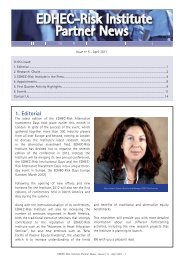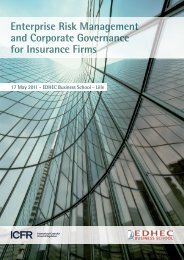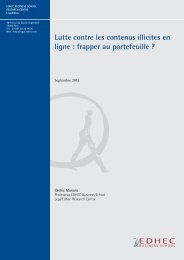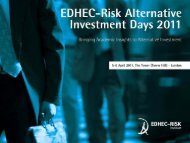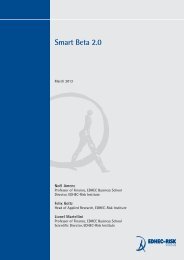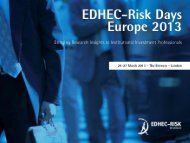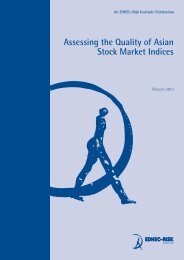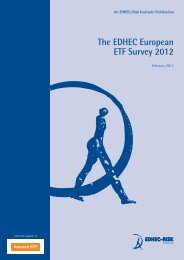The Smart Beta 2.0 Approach - EDHEC-Risk
The Smart Beta 2.0 Approach - EDHEC-Risk
The Smart Beta 2.0 Approach - EDHEC-Risk
Create successful ePaper yourself
Turn your PDF publications into a flip-book with our unique Google optimized e-Paper software.
An ERI Scientific <strong>Beta</strong> Publication — <strong>Smart</strong> <strong>Beta</strong> <strong>2.0</strong> — April 2013<br />
Copyright © 2013 ERI Scientific <strong>Beta</strong>. All rights reserved. Please refer to the disclaimer at the end of this document.<br />
27<br />
2. Controlling the <strong>Risk</strong>s of <strong>Smart</strong> <strong>Beta</strong> Investing:<br />
<strong>The</strong> <strong>Smart</strong> <strong>Beta</strong> <strong>2.0</strong> <strong>Approach</strong><br />
priori far from the true MSR based on true population values) eventually dominates a "bad" proxy<br />
(i.e., a proxy based on parameters plagued with substantial estimation risk) for a "good" target (i.e.,<br />
a target a priori close to the true MSR based on true population values).<br />
Hence, different portfolios are intuitively expected to incur more estimation risk or more optimality<br />
risk. For example, investing in Equal-Weighted (EW) benchmarks involves no estimation risk, since<br />
no parameter estimates are required, but arguably a large amount of optimality risk, since these<br />
benchmarks are not expected to be good proxies for the corresponding true MSR portfolios, unless<br />
all constituents have the same expected return, the same volatility and the same correlations. In<br />
other words, holding EW portfolios, which are not subject to estimation risk, involves an opportunity<br />
cost related to the fact that their Sharpe ratio may be dramatically inferior to the Sharpe ratio of the<br />
true MSR. On the other hand, investing in GMV or ERC (Equal <strong>Risk</strong> Contribution) benchmark involves<br />
more estimation risk compared to EW benchmarks, because covariance parameter estimates are<br />
needed, and possibly less optimality risk if it turns out that these heuristic benchmarks are closer<br />
to the optimal MSR benchmarks than is the EW benchmark. Finally, investing in MSR benchmarks<br />
involves even more estimation risk, since (possibly very noisy) expected return parameters are used<br />
in addition to covariance parameters; on the other hand, it does not involve any optimality risk since<br />
the target portfolio would coincide with the true optimal portfolio in the absence of estimation risk.<br />
In this context, it is useful to first propose an empirical analysis of optimality risk taken in isolation,<br />
i.e., in the absence of any estimation risk. To conduct this analysis, we consider a large number of<br />
possible equity universes, defined in terms of many different possible reasonable true population<br />
values for risk and return parameters, and measure the difference for these parameter values<br />
(in terms of ex-ante Sharpe ratios, i.e., based on true parameter values) between the true MSR<br />
portfolios and various heuristic portfolios, as well as various combinations of these portfolios<br />
(see Martellini, Milhau and Tarelli, 2013, for more details). We then analyse the distribution of this<br />
distance across all possible sets of parameter values so as to generate an absolute assessment of<br />
optimality risk for various heuristic portfolios, as well as a relative assessment of optimality risk<br />
amongst competing heuristic portfolios. For example, this analysis allows us to answer questions<br />
such as what is the probability (across all tested parameter values) that the GMV portfolio is closer<br />
than the EW portfolio to the (true) MSR portfolio, hence allowing us to provide a quantitative<br />
comparison of the optimality risk involved in EW versus GMV (or any other heuristic) benchmark.<br />
In a second step, estimation risk is introduced so as to help measure the distance of various<br />
heuristic benchmarks using imperfect estimates with respect to the true MSR portfolio. This<br />
analysis allows us to analyse the interaction between estimation risk and optimality risk,<br />
and allows us to answer questions such as the following: Given realistic estimation errors<br />
in the covariance matrix and expected returns, what are the chances that an imperfectly<br />
estimated MSR, which suffers only from estimation risk (estimated MSR different from true<br />
MSR) will be closer to the true MSR portfolio in terms of ex-ante Sharpe ratios compared to a<br />
GMV portfolio (for example) which is subject to optimality risk (because the true GMV portfolio




